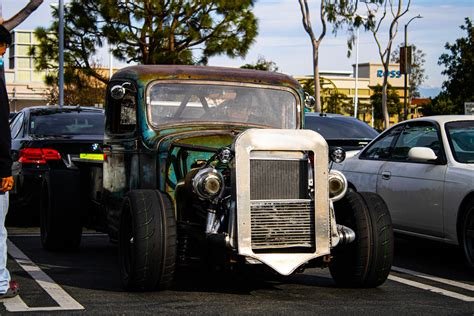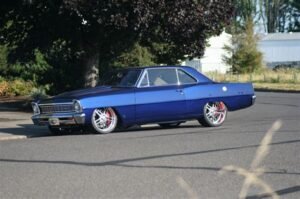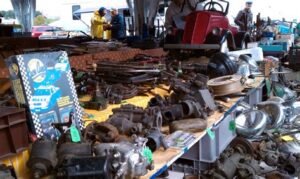
The appeal of the rat rod—its intentionally rough, unpolished demeanor—hadn’t been lost on the collective heart of gearheads and hot rodders alike. Built often from cast-off and salvaged materials, the DIY ethos mixed with an attitude of rebellion against norms in automotive construction defines the rat rod. If you’re about to undertake your own rat rod project, it’s important that you know all the main modifications. This article makes you aware of all the key elements involved in customizing a rat rod, right from the issues related to engine replacement to the painting job.
The Engine: Heart of the Rat Rod
The engine is the soul of any automobile, and rat rods are no exception. While performance is often a secondary concern, a reliable and powerful engine is in order for enjoyable driving.
Engine Choices for Rat Rods
What’s cool about rat rod builds is the fact that they come in so many forms. Powerplants can range from a vintage V8 to a modern fuel-injected unit. Some of the more popular powerplants to grace rat rods over the years include:
Classic V8 Engines
- Small Block Chevy: Because it is cheap and parts are easily available
- Ford FE and 351 Windsor: For sheer power and torque
- Chrysler Hemi: Iconic Rumble and Performance
Other Modern Engine Options
- LS Series (Chevy): Modern technology for better efficiency and power
- Ford Coyote: A strong and reliable choice with a more modern twist
- Mopar Hemi: Classic appearance, yet modern performance
Things to Consider w/Engine Swaps
If you decide on swapping an engine, careful planning needs to be undertaken. Some of the things you must consider in this respect are:
Engine Compatibility
Ensure the chosen engine will work in the vehicle’s chassis and with its transmission. Modifications may be required in the mounting system, wiring, and plumbing for proper fitment.
Transmission Matching
Choose a transmission type to complement the selection of the engine. You can choose the type of transmission—manual or automatic—along with gear ratios that would serve best your style of driving.
Chassis and Suspension: The Foundation of Your Rat Rod
The chassis and suspension form the bedrock of your rat rod, which is where stability, handling, and ride quality come from. In most rat rod builds, the chassis and suspension are being modified or replaced either for performance enhancements or for a certain desired look and feel.
Chassis Modifications
Some of the popular chassis modifications of rat rods include:
Frame Modification
Depending on the decided engine fitted and suspension setup, one may have to modify the existing frame or even fabricate a custom frame in order to accommodate the new components.
Tubbing
Widening the rear wheel wells to accommodate bigger tires, or a wider rear axle. Tubbing enhances traction and gives your rat rod wider stance.
Suspension Upgrades
Rat rod suspension upgrades generally involve one of three things: lowering the ride height, improving handling, or making off-road capability possible.
Lowering the Ride Height
The lowering springs, coil over shocks, or adjustable suspension parts will produce dramatic changes in stance and appearance for the car. Definitely, this will help improve the handling and give your rat rod an aggressive look that you have been searching for.
Improving Handling
Upgraded shocks, sway bars, and adjustable suspension parts give great handling and stability for the rat rod, mainly on corners during aggressive driving.
Off-Road Capability
Modifications for rat rods intended for off-road adventures include lifted suspension, bigger tires, and skid plates to further ensure increased ground clearance and improved handling over rough terrain.
The Body: Rebuilding the Shell
The body of your rat rod is where your creativity and personal style really take centre stage. The beauty of rat rods is embracing imperfections and heralding the raw, weathered feel of days bygone.
Body Modifications
Some rat rod body modifications include:
Bodywork and Patina
Everything in rat rod bodywork is all about leaving the imperfections. In fact, this is all about making the vehicle appear weathered and distressed, with most of the rust, dings, and scratches intact or accentuated.
Chopping and Sectioning
For sure, chopping off the roof and sectioning the body are among those surefire methods to dramatically alter the proportions of the vehicle for a more aggressive and unique profile.
Custom Panels and Fabrication
You could be fabricating custom panels, doors, or even sections of the body in your vision.
Painting Your Rat Rod
The paint on a rat rod is the main attribute that provides character to it. You aren’t after the idealism of perfection in a factory finish; rather, it’s one of distressed, weathered, or even unfinished.
Patina Finishes
Patina finishes are intentionally rough or irregular; many of them have several layers of paint worn off, rusted, or otherwise marred. It is possible to create such finishes by painting multiple layers, sanding back, and then creating the textures by acid etching or applying solutions to induce rust.
Flat or Matte Finishes
Flat or matte paints provide a non-reflective surface that will give your rat rod an industrial and rugged look. These can be produced by specialized paint or by the addition of a flattener to standard paint.
Unfinished Look
Some rat rod builders leave the look unfinished by leaving the metal bare or putting primer on for a finishing touch. This will leave the vehicle with a raw and unfinished charm.
Wheels and Tires: Rolling with Style
The wheels and tires of a rat rod are an essential ingredient of its complete character. Besides providing contact with the ground, they introduce an important visual element.
Wheel Choices
Most of the wheel choices that happen to be employed on rat rods have to do with achieving a classic look with a rugged, ratty touch. Options toward this include:
Steel Wheels
Steel wheels are the staple of most rat rod builds. The finish can be painted, powder coated, or just left bare to add to the ruggedness of the build.
Vintage Wheel Designs
Original or reproduction vintage wheels, like those from the 1930s, 40s, or 50s, help give the build that nostalgic touch.
Custom Wheel Designs
Some of the rat rod builders go for custom wheel manufacturing, which gives complete freedom in terms of design, size, and offset. In such a case, one can actually make a truly unique wheel.
Tire Considerations
The tires that will be used for a rat rod often depend on where and how the vehicle is going to be used and what style is being pursued. To consider:
Tire Size and Width
This is not only important in terms of achieving a desired stance but also helps in handling. Wide tires add to traction but at the same time, have an effect on the turning radius.
Tire Profile
The aspect ratio defines the height of the sidewall of the tire. Lower-profile tires can give your rat rod more aggressive appearance and increase its handling ability, whereas taller tires will make for a smoother ride and higher ground clearance.
Tire Tread Pattern
The pattern of tire tread can affect a number of things in the vehicle, including traction, noise level, and general aesthetics. Most rat rods bear tires with aggressive tread patterns, signaling their tough nature and sometimes their off-road ability.
In all, rat rod modification is a journey into creativity and self-expression. Understanding the main issues of engine swap, chassis modification, bodywork, painting, wheel, and tire selection will help in building one unique ride, expressing your individual style and raw, disobeyed spirit of the rat rod movement.




